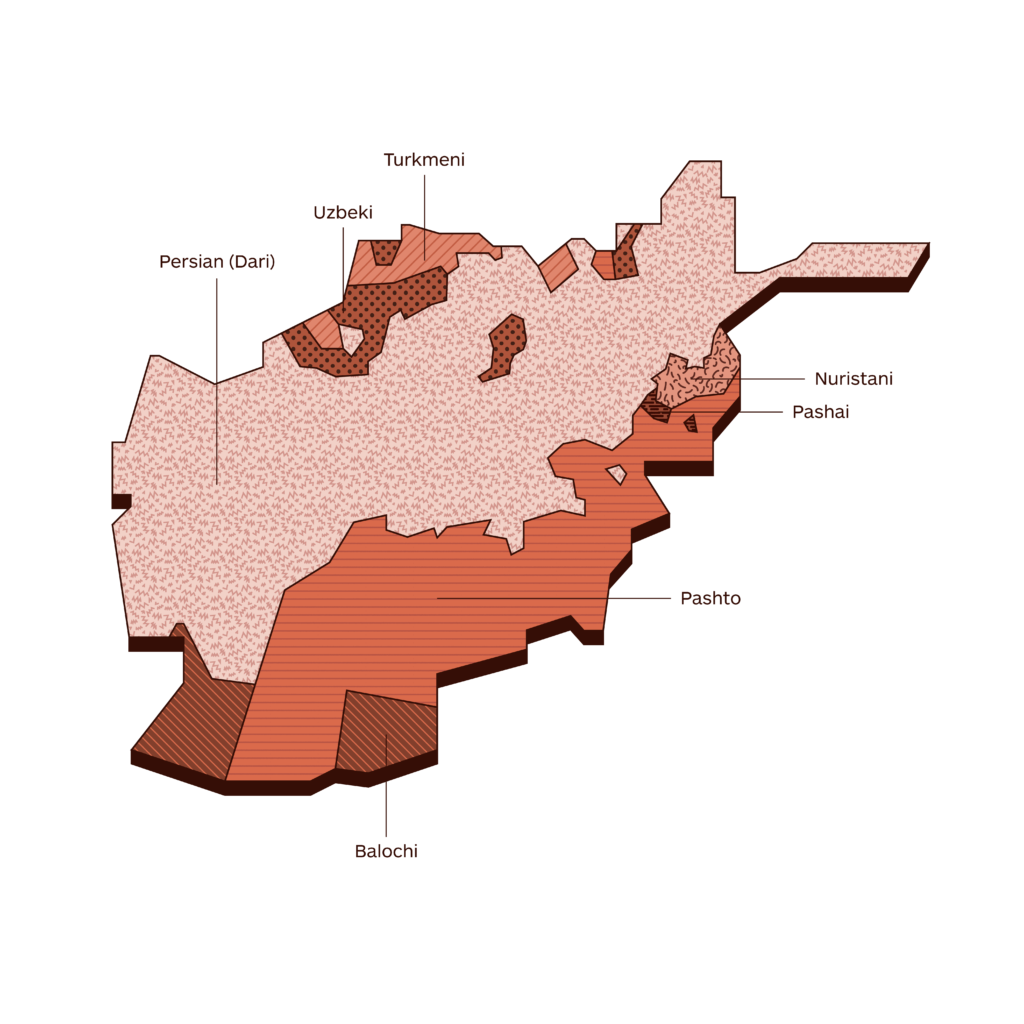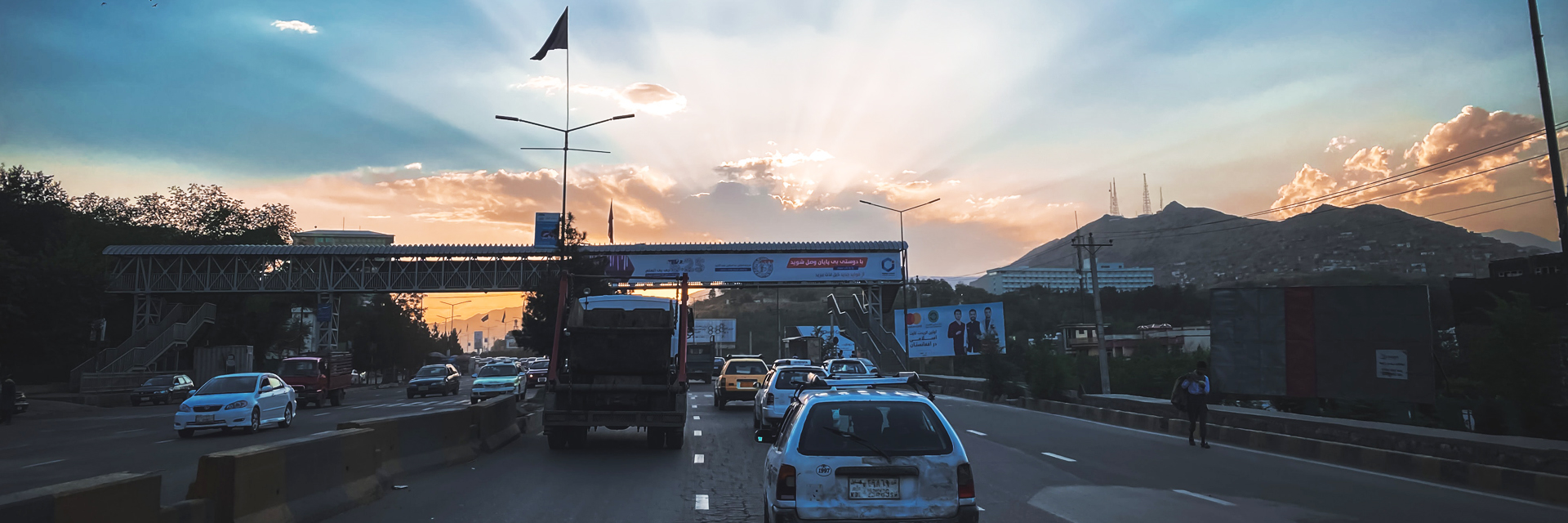Asia
LANGUAGE INSIGHT
Official language
Pashto (45%; 19 mln), Persian (33%; 13.9 mln)
Actual languages
Pashto (45%; 19 mln), Persian (33%; 13.9 mln), Uzbek (7%; 2.9 mln), English (4%; 1.68 mln), Turkmen (3%; 1.26 mln), Urdu (2%; 844k), Arabic (1%; 422k), Balochi (1%; 422k), Nuristani (1%; 422k), Pashayi (1%; 422k), other (2%; 844k)
What the top 150 best localized websites in the world do in Afghanistan
(Top 150 websites listed in the Global by Design ranking – published annually by Byte Level Research, this report provides a list of globally localized websites, showcasing best practices and emerging trends in their globalization)
- 3/150 localize by translating into Arabic
- 3/150 localize by translating into Arabic, Persian and Urdu
- 2/150 localize by translating into both Persian and Urdu
- 1/150 localizes by translating into both Arabic and Persian
- 1/150 localizes by translating into German
-
3M
-
ABB
-
Accenture
-
Adidas
-
Adobe
-
Airbnb
-
Aldi
-
Amazon
-
American Airlines
-
American Express
-
Apple
-
Audi
-
Autodesk
-
Avis
-
Bayer
-
BMW
-
Booking.com
-
Bosch
-
British Airways
-
Bumble
-
Burberry
-
BYD
-
Canon
-
Capgemini
-
Cartier
-
Caterpillar
-
Chevrolet
-
Cisco Systems
-
Citibank
-
Coca-Cola
-
Costco
-
Dell
-
Deloitte
-
Delta
-
DHL
-
Disney+
-
Dyson
-
eBay
-
Eli Lilly
-
Emirates
-
Ernst & Young
-
Facebook
-
FedEx
-
Ford
-
Four Seasons
-
Fujifilm
-
GE
-
Gillette
-
GoDaddy
-
Google
-
Gucci
-
Haier
-
Heineken
-
Hermès
-
Hertz
-
Hilton
-
Hisense
-
Hitachi
-
Honda
-
Hotels.com
-
HP
-
HP Enterprise
-
HSBC
-
Huawei
-
Hyatt
-
Hyundai
-
IBM
-
IKEA
-
Intel
-
InterContinental Hotels
-
J&J
-
Jack Daniel's
-
Jehovah’s Witnesses
-
John Deere
-
Kellogg's
-
Kia
-
KPMG
-
L'Oréal
-
Land Rover
-
LEGO
-
Lenovo
-
Lexus
-
LG
-
Louis Vuitton
-
Lululemon
-
LUSH
-
Marriott
-
MasterCard
-
McDonald's
-
Mercedes-Benz
-
Merck
-
Microsoft
-
Mitsubishi Electric
-
Nestlé
-
Netflix
-
Nike
-
Nikon
-
Nintendo
-
Nio
-
Nissan
-
NIVEA
-
Oracle
-
Pampers
-
Panasonic
-
PayPal
-
Pepsi
-
Pfizer
-
Philips
-
Pitney Bowes
-
Porsche
-
Procter & Gamble
-
PWC
-
Revolut
-
Rolex
-
Royal Caribbean
-
Salesforce
-
Samsung
-
Sanofi
-
SAP
-
Sephora
-
Shopify
-
Siemens
-
Sony
-
Spotify
-
Starbucks
-
Steelcase
-
Stripe
-
Subaru
-
Tesla
-
The Church of Jesus Christ of Latter-day Saints
-
Tiffany
-
Tinder
-
Toshiba
-
Toyota
-
TripAdvisor
-
Uber
-
United Airlines
-
UPS
-
Visa
-
Volkswagen
-
Volvo Cars
-
Vrbo
-
Walmart
-
Western Union
-
Wikipedia
-
Wise
-
WordPress
-
Workday
-
Xerox
-
Xiaomi (Mi)
-
Zara
-
Zoom
Introduction
While there are more than 30 languages and accents spoken in Afghanistan, Dari and Pashto are National and the main two languages that have the highest number of speakers. When it comes to these two languages though, according to Central Statistics Organization of the country, Dari has the highest number of speakers – almost around 80 percent of Afghan population can use it as their communication tool in everyday discourses.
Further, considering the wide range of Dari speakers, one should not be surprised that there are some variations inside Dari. For example, Tajiki Dari is commonly used in Northern areas of the country while Hazaragi Dari is common in central provinces. Needless to say, most people of these areas can understand generally what a speaker from the other area talks and uses, given a possible discourse between them.
There are, however, other languages as popular as third and forth in terms of the number of speakers. One is Uzbiki also commonly spoken in Northern provinces of Afghanistan.
Language
Official language
Pashto (45%), Persian (33%)
The people of Afghanistan form a complex mosaic of ethnic and linguistic groups. Pashto and Persian (Dari), both Indo-European languages, are the official languages of the country. More than two-fifths of the population speak Pashto, the language of the Pashtuns, while about half speak some dialect of Persian. While the Afghan dialect of Persian is generally termed “Dari”, a number of dialects are spoken among the Tajik, Ḥazāra, Chahar Aimak, and Kizilbash peoples, including dialects that are more closely akin to the Persian spoken in Iran (Farsi) or the Persian spoken in Tajikistan (Tajik). The Dari and Tajik dialects contain a number of Turkish and Mongolian words and the transition from one dialect into another across the country is often imperceptible. Bilingualism is fairly common, and the correlation of language to ethnic groups is not always exact. Some non-Pashtuns, for instance, speak Pashto, while a larger number of Pashtuns, particularly in urban areas, have adopted the use of one of the dialects of Persian.
T-index
T-Index ranks countries according to their potential for online sales.
Actual languages
Uzbek (7%), English (4%), Turkmen (3%), Urdu (2%), Arabic (1%), Balochi (1%), Nuristani (1%), Pashayi (1%), other (2%)
English
Very Low proficiency (EF) – scored 79 out of 100 countries/regions in the world – 17/24 in Asia
Demography
Capital: Kabul
Currency: Afghan afghani
Population: 42.23 mln
Population density: 57.1/km2
Economy
GDP: 19.101 billion USD (2019)
GDP per capita: 501.115 USD (2019)
Exports: $1.27B (2018)
Statistics
Internet users:20% penetration, 7.65 million
Unemployment rate: 11.16% (2020)
Urbanisation: 25.75% (2019)
Literacy: 43% (2020)
Conventions
Numbering system
The Persian numbering system is a mathematical notation which uses Eastern Arabic numerals – In Persian, the decimal separator is called “momayyez” and is written as a /. There is no real difference between the comma and the momayyez (٫) used to separate groups of three digits; anyway this is not standard.
Date format: yyyy-mm-dd
Time: 24h time system (no daylight savings time)
Country code: 0093
Language data sources: Worldatlas/Britannica//EF/Wikipedia; Demography data sources: IMF/Worldometers; Conventions data source: Wikipedia; Economy data sources: WTO/OEC/CIA/Esomar/Datareportal; Statistics data sources: Datareportal/WorldBank/UN/UNESCO/CEIC/IMF/Culturalatlas/Commisceoglobal

The new 2021 T-index
Reach most of the online purchasing power
T-Index ranks countries according to their potential for online sales. It estimates the market share of each country in relation to global e-commerce.
Try it nowFacts and data
Economy
Imports
$10 billion (2018). Peat ($487M), Wheat Flours ($477M), Raw Sugar ($379M), Aircraft Parts ($373M), and Inedible Fats and Oils ($358M). Partners: United Arab Emirates ($1.87B), Pakistan ($1.67B), China ($977M), Iran ($908M) and India ($782M)
Financial inclusion factors (over 15 years of age)
• 15% have an account with a financial institution
• 1.1% have a credit card
• 0.9% have a mobile money account
• 0.5% make online purchases
Ease of doing business
It is easy to conduct business (rated 66.1 out of 100) ranked 8th out of 8 South Asian countries and 167th out of 190 countries worldwide (2020, World Bank)
Exports
$1.27 billion (2018).Grapes ($237M), Insect Resins ($104M), Gold ($93.9M), Coal Briquettes ($87M), and Tropical Fruits ($82.9M). Partners: Pakistan ($518M), India ($446M), United Arab Emirates ($120M), China ($24.4M), and United States ($22.7M)
Main local online stores
Amtaa, Afghan Bazar, Azad Bazar, afom.af, JVBazar.com and zarinas.com
Economic freedom
Mostly not free’ (rated 51.5 out of 100) ranked 41st out of 45 Asia-Pacific countries and ranked 152nd out of 186 countries worldwide (2019, Heritage Foundation and Wall Street Journal)
Economy data sources: WTO/OEC/CIA/Esomar/Datareportal
Service Imports (2015)
Source: OEC
Service Exports (2015)
Source: OEC
Most specialised products by RCA Index
Specialisation is measured using Revealed Comparative Advantage, an index that takes the ratio between Afghanistan observed and expected exports in each product
Source: OEC
Most complex products by PCI
Product Complexity Index measures the knowledge intensity of a product by considering the knowledge intensity of its exporters
Source: OEC
Export Opportunities by Relatedness
Relatedness measures the distance between a country's current exports and each product, the barchart show only products that Afghanistan is not specialized in
Source: OEC
Media
Media language
Dari, Pashto
The press
Hasht-e Sobh (“Daily 8 a.m.”) – private, secular daily
Hewad – government- sponsored daily
Anis – government– sponsored daily
Mandegar – private, daily
Weesa – private daily
Arman-e Melli – private daily
The Daily Afghanistan – private
Daily Outlook – private, English language
Afghanistan Times – officially funded, English language
News agency
Bakthar News Agencies – state-run, English-languages pages
Afghan Islamic Press – private, based in Peshawar, Pakistan; English-language pages
TOLOnews News Portal – part of Moby Group – private, English-language pages
Khaama Press – private, English-language pages
Television
National Television Afghanistan – run by state broadcaster (RTA), via terrestrial relays and satellite
Tolo TV – leading private network, operated by Moby Group; via provincial relays and satellite
TOLO news – Moby Group’s news network, via satellite; website in English
Lemar TV – private, Pashto-language sister station of Tolo TV
Ariana TV – private, broadcasts terrestrially in many provinces and via satellite to Asia, Europe and North America
Shamshad TV – private, available terrestrially in major cities
1 TV – private, broadcasts to major cities terrestrially
Radio
Arman FM – Afghanistan’s first private radio station, on FM in Kabul and other cities
Arakozia FM – private, operated by Moby Group
Radio Afghanistan – run by state broadcaster National Radio-TV Afghanistan (NRTA) – also operates Kabul Radio FM 93 in the capital and 32 provincial stations
Salam Watandar – non-profit production house, has 47 partner stations
Kilid Group – US/EU-funded public media group comprising 11 local radios
Media data source: BBC
Internet Data
Internet users
20% penetration, 7.65 million
Share of web traffic by device
mobile phones 76.4%, computers 22.7%, tablet and computer 0.9%
Average speed of mobile Internet connection
6.82 Mbps
Average speed of fixed Internet connection
6.92 Mbps
Mobile connection as a percentage of total population: 70%
Percentage of mobile connections that are broadband (3G-5G): 43%
Most popular web search engines
Google (96.3%), Bing and Yahoo (1.8% and 1.2% respectively)
Most used social media
Facebook (69.89%), Twitter (15.02%), Instagram (6.68%), Pinterest (6.3%), YouTube (3.53%)
Internet data sources: Datareportal/Statcounter
Social statistics
Life expectancy
64.96 yrs (2020)
Gender
Women are usually considered “people who belong to the home”. Men are mostly dominant and a lot of work is needed to promote women’s rights. However, it is recommended to be very careful. Men’s dominant attitude will make it hard to ensure a female contribution to society. In the most conservative environments , touching people of the opposite gender that are not either family or close friends is frowned upon. Furthermore, it is considered rude for men to ask an Afghan man about his female family members.
Ethnicity
This used to be a very serious issue and people were judged based on which class or ethnic group they belonged to, but it is not as serious anymore. More than twenty years of war and emigration has changed this for the better. However, some people may still feel proud to be descendants of famous tribes such as Mohammad Zai, Sadozai and Popal Zai.
Religion
Afghan society is a religious society, but not as extremist or fundamentalist as projected in the media or other sources. It is true that people say they are religious and they need time for prayer, but not everyone prays.
Cultural Curiosities
There are many cultural norms that are respected by Afghans. For example the use of the left hand is not accepted when greeting someone or when handling food, due to the fact that it is seen as the hand used for cleaning and hygienic purposes.
Social statistics sources: WorldBank/UN/UNESCO/CEIC/IMF
Tertiary education in Afghanistan
Source: UNESCO
Tertiary education in Afghanistan, by sex
Source: UNESCO
Source: Gallup
Have there been times in the past 12 months when you did not have enough money to buy food that you or your family need?
Source: Gallup
The Data Factbook is a work in progress project. Our community is helping us to fill it up always with new and updated data. Your contribution is precious. If you want to help us, please write your advices at imminent@translated.com
Languages research
Languages spoken in Afghanistan

The geographical distribution of languages that you will find in the maps published in this section is a work in progress. Our community is helping us to fill it up with always new and updated data. Your contribution is precious. If you want to help us, please write to imminent.factbook@translated.com
Photo credit: Sohaib Ghyasi, Unsplash


